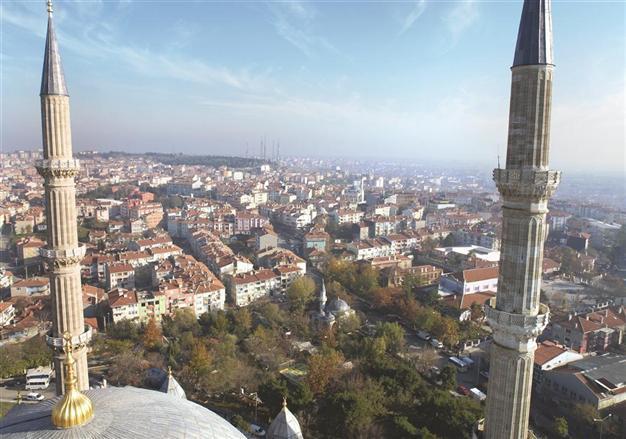A living legend: Hafız Burhan
Wilco van HERPEN

In the minaret, Mimar Sinan managed to build three stairs that lead to three different balconies. How he did that is an architectural miracle.
As you may or may not know, I am married to Gonca Gürses. While in Edirne for my television program, I was confronted with a very important part of her family’s past. The name Gürses has a meaning, a very special meaning. It means “strong voice.” During the last period of the Ottoman Empire, it was decided that everybody should adopt a surname. The grandfather of Gonca, Hafız Burhan Gürses, worked as a muezzin (the man who issues the song-like call to prayer) in Burhaniye, Balıkesir. He had a beautiful, strong voice, and during the period when everyone had to choose a surname, his singing teacher came up with the name Gürses. Hafız Burhan was a living legend in his professional field. He started his singing career with an education in Turk Sanat music with Munir Nurettin Selcuk. As the story goes, Hafız Burhan’s voice was so beautiful that it made Nurettin jealous. Wherever Hafız Burhan would call the namaz (prayer), people would stop talking or walking and listen to the harmonic voice of Gonca’s grandfather.Architectural miracle
During one of his many trips in Turkey he visited Edirne with his uncle. It was the year 1925, and the 23-year-old Hafız Burhan, being a young lad, was always up for some fun. When entering a minaret, his uncle took one flight of stairs and Hafız Burhan took another. You should know that the minaret of the Selimiye Mosque (built by Mimar Sinan) has an as yet unsolved secret. In the minaret, thin as a spear, Mimar Sinan managed to build three stairs that lead to three different balconies. How he did that is an architectural miracle, but when Hafız Burhan and his uncle started to climb the stairs, they ended up at different balconies. Hafız Burhan ended up on the upper balcony and waited for his uncle to come, but when he heard a sound coming from below, he bent over the balcony and looked down. He could not see his uncle, who was on the second şerefe. From this place it is impossible to see the balconies that lay under the third balcony. Hafız Burhan started his ezan (call to prayer), but the wind was so strong that the moment he opened his mouth the melody was swallowed by the wind and disappeared into the air. Nobody heard the poor muezzin calling the prayer. Hafız Burhan went down the stairs and at the entrance he chose the stairs that his uncle had chosen. Finally, he reached the second balcony and started again with the ezan. This time, the people of Edirne, hearing the wonderful voice, all looked up and listened to the beautiful sound of Hafız Burhan. They were surprised because this was not the voice of the muezzin that they were used to hearing. For Gonca’s grandfather, this was one of the highlights of his life and he would tell the story over and over to my father-in-law and later to his grandchildren.
Climbing stairs
Knowing this story, climbing the stairs of the Selimiye Mosque became a special “historical” family adventure. So far, nobody in the Gürses family had been able to climb those stairs again and it was me who, in the name of my father-in-law, started this adventure. Downstairs, at the base of the minaret, the three stairs were waiting in front of me. Which one to choose? I tried my luck and started climbing the stairs. I walked and walked; it was as if this was a never-ending story. Since the minaret was very narrow, the spiral I was making climbing the stairs made me dizzy. Finally, I saw the door of the upper balcony glowing in the distance. Just a couple more steps and I would be there. My goodness, climbing 230 stairs is not an easy thing to do. And in the past the muezzin used to do this every day; five times.
I made it and had to wait a couple of minutes to find myself again. I looked around. The view was amazing; I was lucky since it was a beautiful day. From this point I could see Greece on one side and a bit of the vast planes of Thrace on the other side. Looking down from this point, the mosque seemed even bigger than when you stood in front of it. So this was the place where the strong voice of Hafız Burhan got lost in the wind. I decided to give it a try; not that my voice is as beautiful as Hafız Burhan, but I was curious if people would hear me. I sang a nursery rhyme, but no matter how much I tried nobody seemed to notice me. A bit disappointed with the result, I stopped singing and returned to what I am good at: taking pictures. For me, this became an unforgettable adventure and whenever I look at the pictures I took from the balcony of the minaret of the Selimiye Mosque, I remember the story of Hafız Burhan, a grandfather that I unfortunately never got to know.
















